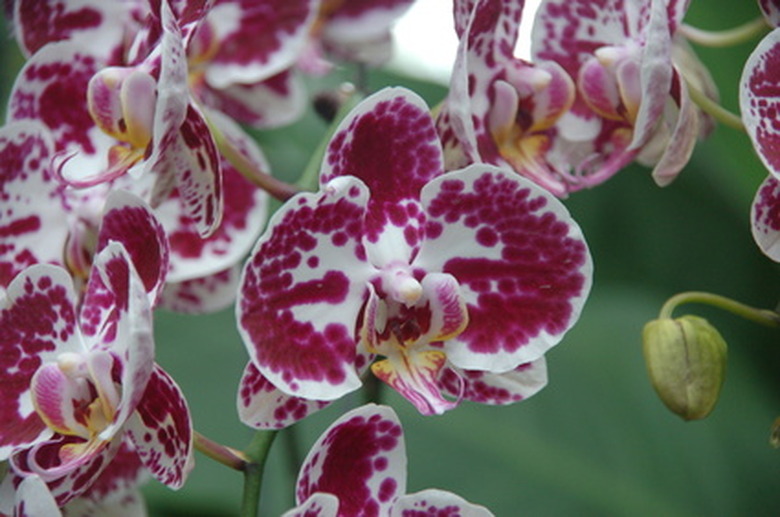How To Care For A Wilsonara Ruby Eyes Orchid
Things Needed
- Pencil
- Orchid-specific fertilizer
- Distilled or reverse-osmosis filtered water
- Growing light
- Orchid stakes and clips
- Pot (for replanting)
- Orchid bark growing medium
- Sphagnum moss
- Sharp knife or pruning shears
Orchids, as a family, are a diverse, ever-changing collection of over 28,000 species found everywhere from rain forests to deserts. While difficult to reproduce in the wild, botanists and gardeners are able to grow orchids successfully at a rapid rate using controlled conditions. New orchid hybrids appear regularly, including the intergeneric Wilsonara, which is a cross of Odontoglossum, Oncidium and Cochlioda orchids. The Aloha Sparks 'Ruby Eyes' cultivar is just one of the prolific members of this hybrid that can enhance any greenhouse or indoor orchid collection.
Step 1
Place Ruby Eyes cultivars in a location that maintains a daytime temperature between 70 and 85 degrees F and a nighttime temperature of 50 to 60 degrees F. During winter months, orchids need to be moved away from windows to avoid cold damage. Use grow lamps during this time period to maintain optimal temperatures.
Step 2
Situate Wilsonara hybrids by east- or south-facing windows with light shade for best results. Dark green foliage indicates that more light is needed, while reddish-green foliage indicates that the Ruby Eyes is getting too much light.
- Orchids, as a family, are a diverse, ever-changing collection of over 28,000 species found everywhere from rain forests to deserts.
- Place Ruby Eyes cultivars in a location that maintains a daytime temperature between 70 and 85 degrees F and a nighttime temperature of 50 to 60 degrees F. During winter months, orchids need to be moved away from windows to avoid cold damage.
Step 3
Utilize growing lamps if you do not have adequate natural lighting available. Hang at least two 40-watt growing lamps 6 inches above the top of the orchids and keep plants lit 12 hours per day to achieve proper lighting levels.
Step 4
Water orchids when soil becomes slightly dry, adding only enough water to moisten the soil. Stick a pencil into the potting medium. If the wood is dark and damp when you pull it back out, wait for another day or so before watering. If growing outdoors, increase watering as outdoor temperatures increase.
Step 5
Maintain a constant humidity level of 50 to 65 percent for healthiest growth and flower production. Misting with distilled water and the use of humidity trays can help to maintain proper levels around the orchids.
- Utilize growing lamps if you do not have adequate natural lighting available.
- Misting with distilled water and the use of humidity trays can help to maintain proper levels around the orchids.
Step 6
Apply an orchid-specific liquid fertilizer every other week, diluted to half the recommended strength. Moisten the soil before applying fertilizer.
Step 7
Eliminate pests by wiping down foliage with a warm, soapy cloth. Utilize insecticides only in extreme cases, with great caution, as orchids are extremely sensitive to chemical exposures. Purchase insecticides specifically labeled only for orchids or ornamental plants, and follow manufacturer's directions to the letter.
Step 8
Repot Wilsonara varieties once every 2 years, after the flowering period has ended. Fill the new container two thirds full with an orchid bark potting medium, then center the plant on top with roots spread out. Pack more orchid bark tightly around the plant to the top of the container to hold the orchid securely in place.
- Apply an orchid-specific liquid fertilizer every other week, diluted to half the recommended strength.
- Utilize insecticides only in extreme cases, with great caution, as orchids are extremely sensitive to chemical exposures.
Tip
Cease watering Wilsonara orchids for 3 to 5 days after repotting to help them recover from shock.
Warning
Softened or municipally treated water sources contain minerals that can stunt root growth. Use distilled or reverse-osmosis filtered water for best results. Overfeeding and overwatering are common causes of orchid failure.
